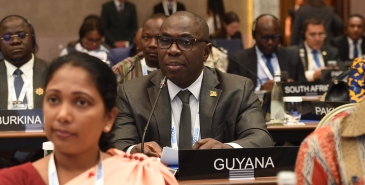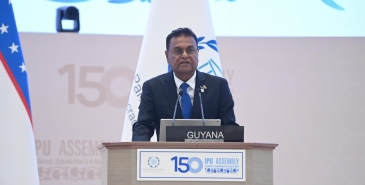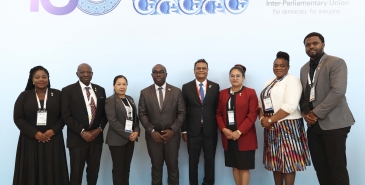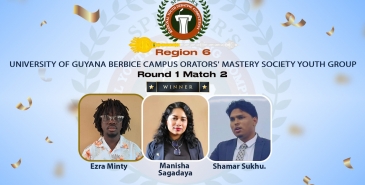Diplomatic Relations between Cuba and Guyana
Speech delivered at: 34th Sitting- Tenth Parliament - 03 January, 2013
03 January, 2013
6746
Dr. Roopnarine: Thank you, Mdm. Deputy Speaker. For me, who from the time of my childhood to this day, has drawn strength and inspiration from the audacity, creativity, endurance and generosity of the Cuban Revolution, it is a particular privilege and honour to rise today in this august House to speak in support of the motion standing in the name of my friend, the Hon. Minister of Foreign Affairs to mark the 40th Anniversary of the establishment of diplomatic relations between the Cooperative Republic of Guyana and the Republic of Cuba.
I have discussed with the Hon. Minister and my colleagues on this side of the House an amendment to the motion that seeks to give a more complete picture of the historical context surrounding the establishment of those relations. The amendment standing in my name seeks to provide a new Whereas Clause at the threshold of the motion. It reads as follows:
“Whereas the Hon. Mr. Michael Manly, the Hon. Dr. Eric Williams, the Hon. Mr. Eral Barrow and the Hon. Mr. Forbes Burnham, the Prime Ministers of the then four independent English-speaking countries of the Caribbean had the foresight and courage to agree to simultaneously establish diplomatic relations between their respective countries and the Republic of Cuba.”
The simple purpose of this amendment is to acknowledge the full historical record which I expect will become clearer in the course of my presentation, but before I go on to describe some of the features of the environment of those complex turbulent and transformative time allow me to make a few observations on the context in which we are meeting today to debate this first motion of the New Year.
Few will deny that this 10th Parliament has so far distinguished itself more as a zone of acrimony and disputatiousness than one of meaning full engagement, collaboration and unity of purpose. Many have been the occasions over the past year when the despairing words of our friend and comrade Mr. Martin Carter of revered memory have floated into my mind. In an address at the Inter-American University of Puerto Rico some time around 1964 on the race crisis. Mr. Martin Carter was moved to remark, and I quote:
“Someone was saying recently that BG needs a consensus. I contend that there is a consensus; a consensus that there should be no consensus and I say that deliberately because the actions of both the leaders and the followers provide enough evidence to support this argument.”
Permit me to state the obvious. The building of consensus demands a high level of commitment from both sides, underpinned by devotion to principle and the spirit of generosity. Where these are lacking – commitment, principle and generosity – calls for cooperation are mere exercises in rhetoric or at best futile wish fullness so in addition to all the other powerful reasons for gratitude to revolutionary Cuba we are thankful that the postponement of the motion to this first sitting of the New Year provides us with the opportunity to depart from our entrenched and embattled ways and to unit, as we in Guyana have always done, in celebration of the revolution’s resilience and achievements and in defence of its right to exist. May the spirit that guides and unites us in our debate on the Cuban motion today infect our deliberations in the days and months ahead.
To return to the historical context: What was the regional and wider situation in 1972, the year of the establishment of diplomatic relations with Cuba? Guyana began the decade of the 70s with a sense of foreboding that the territorial border challenges for Venezuela and Suriname that had escalated dangerously in the immediate post independence years were fast approaching a crisis point. With the imminent lapse of the Geneva Agreement in late February, 1970, military incursions by Venezuela resulted in Guyana, through the United Nations Mission, alerting the security council of this Act of hostility. To widespread relief the temperature was lowered by the initiation of a process of dialogue between diplomatic officials of Guyana and Venezuela. This provided the ground work for the creative diplomatic intervention of Dr. Eric Williams, the Prime Minister of Trinidad and Tobago, who oversaw the Port of Spain meeting of the Foreign Ministers of the two countries in June that culminated in the Protocol of Port of Spain that fills the territorial controversy for a 12-year period.
The signing of the protocol lead to what one commentator called the dramatic flourishing of bilateral cooperation evidenced by Venezuela’s participation in the 1972 Carifesta hosted by Guyana and the normalisation of relations.
On the Suriname front, again on Dr. Williams’ initiative, Prime Ministers Burnham and Sydney held a historic meeting in Port of Spain in April of 1970. The agreement struck at this meeting lead to the demilitarisation of the Upper Courantyne border area and the promotion of bilateral, economic and cultural cooperation, brining to an end the hostilities of 1969.
It was this albeit temporary settling of the border controversies that allowed the Government of Guyana the space to develop and pursue the radical foreign policy initiatives of the period that were to include heightened levels of activism within the councils of the Non-Aligned Movement, the United Nations, as well as in Africa, Latin America and in the Caribbean. The effect of this energetic all round diplomacy was to provide a shield around Guyana against further threats and saber rattling incursions from its eastern and western neighbours.
The earliest initiative that eventually culminated in the establishment of full diplomatic relations with the Republic of Cuba dates from mid 1972 when Guyana joined with Jamaica to sponsor a resolution at a Caribbean Law of the Sea Conference held in the Dominican Republic. The resolution sought to ensure that all independent Caribbean countries should be invited to participate in future meetings of Caribbean countries regarding the law of the sea. Since Cuba was the single Caribbean territory not invited to participate in this conference the resolution was clearly aimed at the reintegration of Cuba into regional councils. Talks began and were deepened at the highest levels between Guyana and Cuba, laying the foundation for the establishment of full diplomatic relations. It was decided that the strategically most effective way forward was to craft a regional approach at the level of CARICOM. Apart from making it more difficult for the US to isolate, target and punish individual countries, the approach was consistent with Guyana’s line on policy coordination within CARICOM; particularly in external negations. This policy was to be formally adopted within the 1973 Treaty of Chaguaramus. This strategic regional approach was pursued by Guyana and culminated in the decision by the four independent CARICOM countries during the October 1972 Chaguaramus Summit to establish diplomatic relations with Cuba. In the words of Fidel Castro, and I quote:
“The establishment of diplomatic relations with Cuba was a challenge to imperialism and nevertheless the English speaking countries of the Caribbean accepted this challenge. It was precisely at a top-level meeting among leaders of these countries held in Trinidad in October, 1972, that the Prime Minister of the Cooperative Republic of Guyana proposed the joint establishment of diplomatic relations with Cuba.”
The US State Department deemed it an unfortunate development.
In the years that followed bilateral relations between our two countries deepened, intensified and flourished. Reciprocal visits of ministerial and trade missions, the establishment of technical assessment agreements and air services agreement that saw Cubana Airways beginning operations in Guyana were all brought together under the umbrella of a mixed commission in 1975. Over the years, since then, Guyanese have been able to benefit from training opportunities in medicine, as we have heard, as well as aeronautical language and other technical fields and recently, as we have heard from previous members, in areas of sports and culture as well.
Cuba’s invaluable assistance to our health sector is perhaps the best known of the various areas of assistance. Starting in 1976, Cuba has been dispatching teams of doctors and other health personnel to increase our capacity to deliver medical care. Part of the price we were to pay for the deepening of our bilateral trade and cultural relations with Cuba was the loss of the PL488 Programme with the United States. There may have been other reasons but I must have missed the explanation. Relations with the USA, while tense and uncomfortable at the beginning of the decade, were to deteriorate more dramatically in 1976.
In late 1975, as the war in southern Africa intensified, Cuba had approached several Caribbean countries for permission to facilitate the movement of its troops and materials to Angola. Barbados and Trinidad refused the request. To its credit and with the support of all the major political forces Guyana provided the transshipment facilities at Timehri, thereby playing its own small part in the eventual decisive battle at Cuito Cuanavale in 1988; an event that turned the tide in favour of the liberation forces in southern Africa and ushered in the collapse of apartheid. In February, 1990, two years after the route at Cuito Cuanavale, Nelson Mandela was released from prison. He went to Havana in July 1991 to thank Fidel Castro personally for Cuba’s assistance in the anti-apartheid struggle and this is what Mandela said:
“The decisive defeat of the racist army in Cuito Cuanavale was a victory for all Africa. It made it possible for Angola to enjoy peace and establish its own sovereignty and for the people of Namibia to achieve to achieve their independence. The decisive defeat of the aggressive apartheid forces destroyed the myth of the invincibility of the white oppressor. The defeat of the apartheid army served as an inspiration to the struggling people of South Africa.”
I now turn to what the motion calls “the tremendous progress made by the Government and people of Cuba in the development of their country”. I can point, as other Members have done, to the achievement in education from nursery to university, we used to say, or to art and culture where the cadres of film makers at the ICAIC (Cuban Institute of Cinematographic Art and Industry) created and refined the language of the new Latin American cinema or the Instituto Superior de Arte (ISA) where our own and other Caribbean painters and sculptors hewn and refine their skill or the sports arena where the exploits of Cuban athletes have become legendary or to the achievement of energy self sufficiency, but I will restrict myself to the achievements in medicine about which we have heard something today and medical research where Cuba, since 1959, has become the world’s unrivaled super power. The scale of Cuba’s achievements on the healthcare front is little short of staggering. The development of Cuban medicine has been a Government priority since the triumph of the revolution in 1959. In 2012 more than 11,000 new doctors graduated, completing their six years of study in quality medical schools; the largest graduating class in the country’s history. Among these recent graduates, 5,315 are Cubans and 5,694 are from 59 other countries in Latin America, Africa and Asia, including the United States with the majority from Bolivia – 2,400, Nicaragua – 429, Peru – 453, Ecuador – 308, Columbia – 175 and Guatemala – 170. At the time of the Cuban Revolution the country had only 6,286 doctors; half of them left for Miami. Thus in one year Cuba trained almost twice the number of doctors present in Cuba in 1959. This resulted from the massive investment in medicine creating universal access to higher education, free of charge in all areas of advanced study. Thus, today there are 24 medical schools in Cuba as compared to only one in 1959. Since 1959 approximately 109,000 doctors have been trained in Cuba. Currently one doctor is available for every 148 Cubans – 6.72 per 10,000 inhabitants. According to the World Health Organisation (WHO) Cuba has the best ratio in the world. These medical professionals staff 161 hospitals and 452 polyclinics around the country. For the 2011/2012 academic year the total number of graduates in medical sciences – Cubans plus those from other countries – reached 32,171, including doctors, dentists, nurses, psychologists and health technology specialists.
In addition to the studies offered at 24 of the country’s medical schools, Cuba trains foreign students at the Latin America School of Medicine (ELAM) in Havana. The school was inaugurated on 15th November, 1999, in order to train doctors in Cuba to serve in the under-developed world. Currently 24,000 students from 116 countries from Latin America, Africa, Asia and Oceana, as well as the USA, are studying medicine free of charge in Cuba. During the period beginning with the first graduating class in 2005 and 2010, 8,594 young doctors have been trained at the school. The 2011 and 2012 graduating classes were exceptional with close to 8,000 graduates. In all, close to 15,000 doctors were trained at ELAM in 25 different specialties.
Within the framework of its international collaboration programmes Cuba additionally trains close to 29,000 students every year in three areas – medicine, nursing and health technology – in eight other countries – Venezuela, Bolivia, Angola, Tanzania, Guinea-Bissau, Equatorial Guinea and East Timor. Since 1963, when Cuba sent its first international medical mission to Algeria, Cuba has been committed to providing healthcare to the planet’s poor in the name of international solidarity and the seven principles of Cuban medicine – equity, no cost, solidarity, accessibility, universality, shared responsibility and justice.
Cuba’s humanitarian missions are unique and have reached four continents. In fact no other country in the world, even the most developed, has created such a network of humanitarian cooperation around the planet. Since its inception, close to 132,000 doctors and other medical personnel have voluntarily worked in 102 countries. In all, Cuban doctors have treated 85 million people around the world and saved 615,000 lives. Currently 31,000 collaborating doctors offer their services in 69 third-world countries.
Within the framework of the Bolivarian Alliance for the Peoples of our America (ALBA) in June, 2004, Cuba and Venezuela launched a broad humanitarian campaign named Operation Milagro (Operation Miracle) offering surgery free of charge to those suffering with cataract and other operable eye ailments who cannot afford the $5,000 to $10,000 price tag of such an operation. This humanitarian effort has been extended to other regions in Africa and Asia and has established 49 ophthalmology clinics in 15 Central American and Caribbean countries. In 2011 more than two million people in 35 countries recovered their eyesight as a result of the mission’s work.
10% of the national budget has allowed Cuba to achieve these exceptional results. Thanks especially to the preventative focus of their medical policy, the country has an infant mortality rate of 4.9 deaths per 1000 live births as compared to 60 per 1000 in 1959. It is the lowest in the Americas; better than in Canada or the US and throughout the third world. Likewise, life expectancy is 78.7 years of age as compare to 60 in 1959 is similar to that in most developed countries and all this in a small Caribbean country under siege.
Cuba has done all of this while withstanding an economic embargo for nearly half of a century from the mightiest power on the planet that costs an estimated $93 billion, equivalent to 12 times the foreign debt of Cuba. Not only did Cuba survive the collapse of the Soviet Union with all that that entailed – the disappearance of markets, of vital supply of food, fuel, spare parts for equipment, a colossal drop in national income – but it did so in spite of the tightening strangle hold of the criminal US embargo. The special period was the supreme test of the will and endurance of the Cuban people.
In a stirring address at the great hall of the University of Havana on the 3rd December, 2008, on receipt of the honourary degree of Doctor of Economics Sciences, Professor Norman Girvan paid tribute to this miracle of survival in this special period. Girvan said this:
“To survive it while preserving many if not most of the gains of your revolution without widespread crime and major social unrest, without brutal political repression of the kind that we have seen in many other countries experiencing much less severe degrees of structural adjustment, for this to have happened defies all social, economic and political logic. I want to say that in my simple way of seeing things I believe that this miracle can only be explained by the practice of a profound participatory democracy in Cuba, with a leadership that explains everything, a people that discusses everything, an economic adjustment that was equitably shared and a people determined to defend their revolution and their independence, no matter what the cost.”
For Girvan, as for many of us in the Caribbean, it is Jose Marti’s Legacy of Internationalism, his proclamation “patria es humanidad”, “the fatherland is humanity”. This internationalism sustained by Che, Fidel and the by the entire Cuban people that provides the psychic bond between us as Caribbean people.
The third RESOLVE clause of our motion commits this House to continue to call for the removal of the unjust and financial embargo against Cuba. Allow me to say that the Helms-Burton Act is not only unjust, it is anachronistic, spiteful and stupid; an opinion shared by many on the American Congress. It was on 12th March, 1996, the United States Congress passed what one commentator has called one of the most regressive and draconian foreign policy initiatives in recent memory. This legislation was enacted in response to a 1996 incident in which the Cuban Air Force shot down two civilian planes belonging to the Miami-based, anti-Castro initiative, Brothers to the Rescue. Congress passed the act in an attempt to place a stranglehold on Cuba's economy in order to facilitate its long-term goal of expelling gastro from office. It has been argued that Helms-Burton proved to be a costly policy, both in terms of the resources it consumed as well as the negative impact it had on Washington's reputation. Impudently called Libertad, the act has failed to bring the Cuban people to their knees. On the contrary, it has stiffened their resolve. It has thought them the value of sacrifice and self reliance. There is a strong and growing opinion in the United States that the Helms-Burton Act continues to hinder US foreign policy. As long as the legislation remains on the books, the argument goes, the possibility of alienating some of the United States' closest allies remains. Further, the act is seen as a prominent example of the country's bloated cold-war infrastructure. It is the view of reasonable people that Helms-Burton is one law that should be discarded into the State Department's trash bin of failed policies.
In closing, Mdm. Deputy Speaker, permit me, from this side of the House, to send to the Cuban Government and the heroic, vertical people of our sister Republic of Cuba our unshakable friendship and solidarity and our gratitude to them for continuing to uphold the dignity of our Caribbean. Long may they continue to be inspired by the visionary words of José Martí: “La Patria es humanidad.” [Applause]
Speech delivered by:
What's New

08 April, 2025
Minister Kwame McCoy promotes Low Carbon Development Strategy in IPU Committee Meeting on Sustainable Development

07 April, 2025
Speaker Nadir Emphasises Guyana’s Commitment to Social Development at IPU General Debate

07 April, 2025
Guyana Delegation Attends 150th Inter-Parliamentary Union Assembly in Tashkent, Uzbekistan

28 March, 2025
University of Guyana Berbice Campus Orators’ Mastery Society Youth Group Clinches Second Win for Region 6 in the Speaker’s Regional Youth Debating Competition 2025

